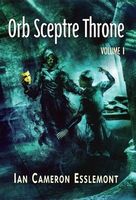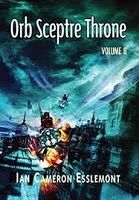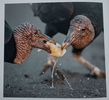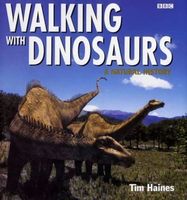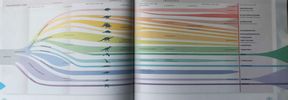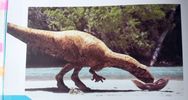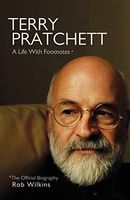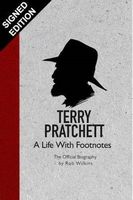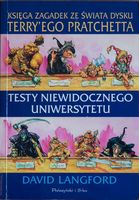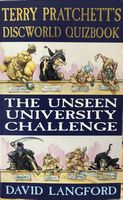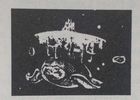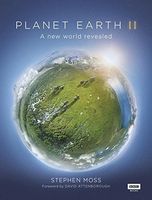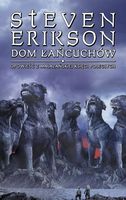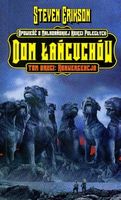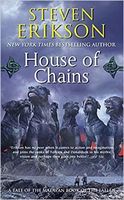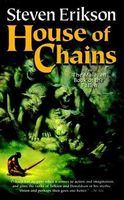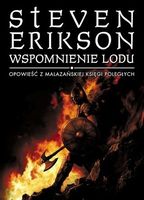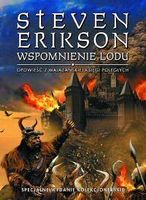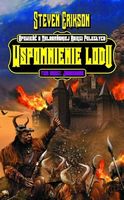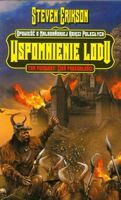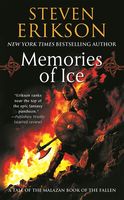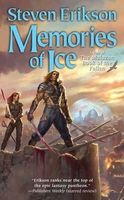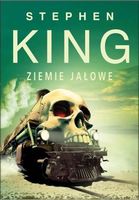 Tytuł: Mroczna Wieża III: Ziemie jałowe
Tytuł: Mroczna Wieża III: Ziemie jałowe
Tytuł oryginału: The Dark Tower III: The Waste Lands
Autor(zy): Stephen King
Tłumaczenie: Zbigniew A. Królicki
Rok wydania: 1991 (ENG), 2002 (PL)
Wydawnictwo: Donald M. Grant (ENG), Albatros (PL)
Dlaczego w bazie: Trzeci tom ośmiotomowej serii Mroczna Wieża, pierwszy w którym pojawiają się żółwie elementy, i to w solidnej ilości!
Poniżej prezentujemy wszystkie siedemnaście fragmentów z żółwimi wzmiankami, część o nazwie geograficznej (Turtle Bay), część o innej nazwie geograficznej, nazwie żółwiej ulicy (The Street of the Turtle), reszta w większości dotyczy istotnej w serii postaci żółwia o imieniu Maturin, imię to tutaj jednak jeszcze nie pada, odniesienia do niego są tylko jako do jednego ze „strażników”.
Pierwsza wzmianka jest w kontekście strażnika:
Postukał w środek kręgu.
– Tam znajduje się Mroczna Wieża, której szukam przez całe życie.
Rewolwerowiec podjął przerwaną opowieść:
– Przy każdej z tych mniej ważnych dwunastu bram Wielcy Dawni postawili Strażnika. Jako dziecko potrafiłem wymienić imiona ich wszystkich, ułożone w wierszyk, którego nauczyła mnie niania i kucharz Hax. Lecz to było dawno temu. Oczywiście był wśród nich Niedźwiedź, Ryba, Lew i Nietoperz. A także Żółw — ten był bardzo ważny.
Rewolwerowiec spojrzał na rozgwieżdżone niebo i zmarszczył czoło w głębokim namyśle. Potem jego twarz rozjaśnił zdumiewająco promienny uśmiech i wyrecytował:
Spójrzcie na Żółwia o ogromnej skorupie!
Co na swych plecach całą Ziemię niesie.
Choć myśli wolno, lecz zawsze rozważnie:
I każdego z nas swym umysłem sięgnie,
Na jego grzbiecie wszystkie śluby składane,
I zna prawdę, lecz pomóc nie jest w stanie,
Choć kocha ziemię i błękit morza,
A nawet takie dziecko jak ja.1
Druga jest nietypowa, dotyczy Turtle Waxu, rodzaju wosku, tłumacz pominął żółwi element, występuje on tylko po angielsku:
Uniósł brew.
– Przepuszczę go razem z tobą przez następną najbliższą myjnię, na jaką trafimy. Nawet pociągnę to cholerstwo woskiem. Dobrze?2
Kolejna wzmianka to nawiązanie do żółwiej powolności:
Runął na ziemię, a robiąc to, zobaczył, jak rewolwerowiec błyskawicznie sięga po broń. Mój Boże – pomyślał, zanim upadł — on nie może być aż tak szybki, nikt nie jest tak szybki, ja jestem niezły, ale przy Susannah zdaję się powolny, a ona przy nim jest jak żółw gramolący się na szklaną górę…3
Pierwsza z wzmianek w kontekście nazwy Turtle Bay:
MILLS CONSTRUCTION I SOMBRA REAL ESTATE
ASSOCIATES WCIĄŻ MODERNIZUJĄ OBLICZE
MANHATTANU!
WKRÓTCE W TYM MIEJSCU STANĄ LUKSUSOWE
APARTAMENTY ZATOKI ŻÓŁWIA! PO INFORMACJE
ZADZWOŃ POD 555-6712! BĘDZIESZ ZADOWOLONY,
ŻE TO ZROBIŁEŚ!
Wkrótce? Może… ale Jake bardzo w to wątpił. Napis był mocno wyblakły i lekko przekrzywiony. Co najmniej jeden artysta, niejaki BANCO SKANK, zostawił na obrazku przedstawiającym apartamenty Zatoki Żółwia swój artystyczny podpis jasnoniebieską farbą w aerozolu. 4
Wierszyk o żółwiu, trochę w kontekście Turtle Bay a trochę w kontekście strażnika:
Spójrzcie na Żółwia o ogromnej skorupie!
Co na swych plecach całą Ziemię niesie.
Jeśli chcesz pójść i włączyć się do zabawy,
Idź tam, gdzie wiedzie Promień łaskawy.
Jake uznał, że rodowód tego wierszyka (jeśli nie jego sens) nie budzi żadnej wątpliwości. W końcu tę część wschodniego Manhattanu nazywano Zatoką Żółwia. To jednak nie wyjaśniało zimnego dreszczu, który nagle przebiegł mu po plecach, ani nieodpartego wrażenia, że oto znalazł następny drogowskaz przy jakimś baśniowym, tajemnym szlaku.5
Przypomniany kawałek wierszyka:
– „Spójrzcie na Żółwia o ogromnej skorupie — mruknął Jake. — Co na swych plecach całą Ziemię niesie”. — Zadrżał.
– Co za dzień! Chłopie!6
Ponownie przypomniany wierszyk:
Opowiadając o tym po raz drugi, mówiąc bardzo wolno, Jake przekonał się, że rewolwerowiec miał rację; teraz przypominał sobie każdy szczegół. Szło mu tak dobrze, że miał wrażenie, iż powtórnie przeżywa to zdarzenie. Opowiedział im o tablicy głoszącej, że w miejscu dawnych Delikatesów Toma i Gerry’ego ma stanąć budynek o nazwie Apartamenty Zatoki Żółwia. Przypomniał sobie nawet wierszyk napisany farbą w sprayu na płocie i wyrecytował go im:
Spójrzcie na Żółwia o ogromnej skorupie!
Co na swych plecach całą Ziemię niesie.
Jeśli chcesz pójść i włączyć się do zabawy
Idź tam, gdzie wiedzie Promień łaskawy.
Susannah dopowiedziała: Choć myśli wolno, lecz zawsze rozważnie, I każdego z nas swym umysłem sięgnie…
– Czy nie tak to szło, Rolandzie?
– Co? — spytał Jake. — Co tak szło?
– Wierszyk, którego nauczyłem się jako dziecko — odparł Roland. — To inne powiązanie, naprawdę wiele mówiące, chociaż nie jestem wcale pewien, czy chcemy to wiedzieć…
A jednak nigdy nie wiadomo, kiedy takie wiadomości mogą się przydać.
– Dwanaście portali połączonych przez sześć promieni — rzekł Eddie. — Zaczęliśmy od Bramy Niedźwiedzia. Zmierzamy tylko do środka… do Wieży… lecz gdybyśmy przeszli aż na drugą stronę, dotarlibyśmy do Bramy Żółwia, prawda?
Roland kiwnął głową.
– Jestem pewny, że tak.
– Brama Żółwia — powtórzył w zadumie Jake, ważąc te słowa w ustach, zdając się je smakować. Potem zakończył swoją relację, mówiąc im, jak usłyszał chóralny śpiew, jak uświadomił sobie, że wszędzie jest pełno twarzy oraz opowieści, jak nabrał przekonania, że natknął się na coś w rodzaju sedna egzystencji. I w końcu ponownie opowiedział o tym, jak znalazł klucz i zobaczył różę. Pod wpływem tych wszystkich wspomnień Jake zaczął płakać, lecz chyba nie zdawał sobie z tego sprawy.7
Znów wierszyk, tym razem złośliwie przerobiony:
– Taak, i pewnie tak jest — rzekł Eddie, blady i ponury. Nagle uśmiechnął się jak dzieciak. — „Spójrzcie na Żółwia, czyż nie budzi zdumienia? Jak wszystko, też jest sługą pieprzonego Promienia”.8
Żółwia ulica oraz posąg żółwia, nawiązanie do strażnika:
Eddie zerknął na ciemniejące niebo i w przemykających po nim chmurach z łatwością dostrzegł ścieżkę Promienia. Znów spojrzał w dół i bez zdziwienia zauważył, że wylotu ulicy biegnącej niemal zgodnie z przebiegiem Promienia strzeże wielki kamienny żółw. Jego gadzi łeb wystawał spod krawędzi granitowej skorupy, a głęboko osadzone ślepia zdawały się patrzeć na nich z zaciekawieniem. Eddie wskazał posąg ruchem głowy i zdobył się na nikły uśmiech.
– Widzisz żółwia o ogromnej skorupie?
Susannah rzuciła okiem na rzeźbę i skinęła głową. Popychając fotel, ruszył przez plac w kierunku ulicy Żółwiowej. Wiszące na słupach zwłoki wydzielały cynamonowy zapach, od którego żołądek podchodził Eddiemu do gardła… Właśnie dlatego, że ta woń wcale nie była obrzydliwa, lecz wręcz przyjemna — korzenny zapach przyprawy, którą dzieciak chętnie posypałby poranną grzankę.
Na szczęście ulica Żółwiowa była dość szeroka, a większość zwisających ze słupów zwłok była prawie zmumifikowana, choć Susannah dostrzegła kilka stosunkowo świeżych: muchy wciąż obsiadały poczerniałą skórę napuchniętych twarzy, a robaki wiły się w gnijących oczodołach. 9
Głos żółwia, zapewne w kontekście strażniczym:
A potem wojna się skończyła i zapadła cisza… na chwilę. Po pewnym czasie głośniki znów zaczęły nadawać. Kiedy? Sto lat temu? Pięćdziesiąt? Czy to miało znaczenie? Susannah uważała, że nie. Liczyło się tylko to, że kiedy znów włączono głośniki, puszczano przez nie w kółko tylko jedno nagranie… to z obłąkańczym waleniem bębnów. A potomkowie dawnych mieszkańców miasta uważali te dźwięki… za co? Za Głos Żółwia? Wolę Promienia?10
Kolejne trzy wzmianki to ulica:
Eddie pchał fotel ulicą Żółwiową i wzdłuż ścieżki Promienia, usiłując rozglądać się na wszystkie strony jednocześnie i starając się nie wciągać nosem fetoru rozkładu. Dzięki Bogu, że wieje wiatr — myślał.11
Eddie miał, jak powiedział kiedyś pewien komik, znowu to samo deja vu: biegł, pchając przed sobą fotel, ścigając się z czasem. Plażę zastąpiła ulica Żółwiowa, ale poza tym wszystko było takie samo. Och, z jedną istotną różnicą: tym razem szukał dworca kolejowego (lub stacji), a nie drzwi na plaży.12
Nieco dalej, na skrzyżowaniu ulicy Żółwiowej z inną, ujrzał wysoki łuk bramy wiodącej do jakiegoś marmurowego budynku.13
Ulica i płaskorzeźba:
Maud żwawo ruszyła ulicą Żółwiową. Jeeves dreptał obok niej. Eddie, który popychał fotel z Susannah, szybko zasapał się i z trudem nadążał. Odstępy między okazałymi gmachami po obu stronach ulicy powoli powiększały się, aż budynki zaczęły przypominać porośnięte bluszczem dworki stojące na rozległych i zarośniętych trawnikach. Eddie zrozumiał, że znaleźli się w bardzo eleganckiej niegdyś dzielnicy. Jeden z budynków górował nad innymi. Zwodniczo prosta konstrukcja z bloków białego kamienia, ze sklepieniem wspartym na wielu kolumnach. Eddiemu znowu przypomniały się filmy o gladiatorach, które tak lubił jako dzieciak. Susannah, która odebrała staranniejsze wykształcenie, przypominał Partenon. Oboje oglądali i podziwiali wspaniałe płaskorzeźby — niedźwiedzia i żółwia, ryby i szczura, konia oraz psa — parami zdobiące fronton budynku. Zrozumieli, że właśnie tego miejsca szukali.
Ani na chwilę nie opuszczało ich nieprzyjemne wrażenie, że śledzą ich dziesiątki par oczu, pełnych nienawiści i podziwu. Kiedy zobaczyli dworzec kolei jednoszynowej, huknął piorun.
Tor — tak samo jak burza — przybywał z południa, łączył się z ulicą Żółwiową i wpadał prosto na stację. Zbliżając się do niej, widzieli, jak po obu stronach ulicy wyschnięte ciała kołysały się na wietrze.14
Dwa kolejne fragmenty to znów żółwia ulica:
W miejscu, gdzie ulica Żółwiowa spotykała się z placem Dworcowym, na bruku był namalowany szeroki czerwony pas. Maud i facet, którego Eddie nazywał Jeevesem, zatrzymali się w bezpiecznej odległości od tego znaku.15
Kiedy schronili się przed ulewą, Eddie przystanął i spojrzeli za siebie. Plac przed dworcem, ulica Żółwiowa i całe miasto, wszystko szybko znikało za szarą kurtyną deszczu. Eddie ani trochę tego nie żałował. 16
Żółwie jako punkt odniesienia w porównaniu:
Pociąg jechał teraz przez góry, które wcześniej widzieli na horyzoncie: ołowianoszare szczyty pędziły ku nim jak wicher, a potem zostawały w tyle, odsłaniając jałowe doliny, w których pełzały chrząszcze wielkości żółwi morskich.17
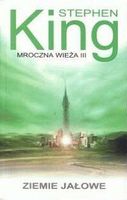


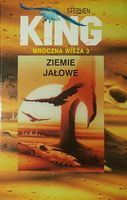


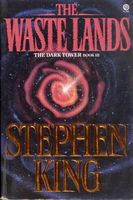
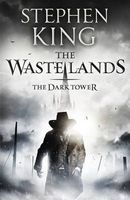

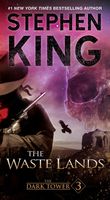
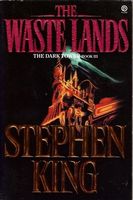
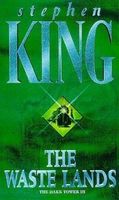
1.
He tapped the center of the circle.
”Here is the Dark Tower for which I’ve searched my whole life.”
The gunslinger resumed: ”At each of the twelve lesser portals the Great Old Ones set a Guardian. In my childhood I could have named them all in the rimes my nursemaid—and Hax the cook—taught to me… but my childhood was long ago. There was the Bear, of course, and the Fish… the Lion… the Bat. And the Turtle—he was an important one…”
The gunslinger looked up into the starry sky, his brow creased in deep thought. Then an amazingly sunny smile broke across his features and he recited:
”See the TURTLE of enormous girth!
On his shell he holds the earth.
His thought is slow but always kind;
He holds us all within his mind.
On his back all vows are made;
He sees the truth but mayn’t aid.
He loves the land and loves the sea,
And even loves a child like me.”
2. He cocked an eyebrow at her. ”Next carwash we come to, I’ll push you through myself. I’ll even Turtle-wax the goddamn thing. Okay?”
3. He dropped, and as he did, he saw the gunslinger’s left hand blur down to his side. My God, he thought, still falling, he can’t be that fast, no one can be that fast, I’m not bad but Susannah makes me look slow and he makes Susannah look like a turtle trying to walk uphill on a piece of glass—
4. MILLS CONSTRUCTION AND SOMBRA REAL ESTATE
ASSOCIATES ARE CONTINUING TO REMAKE THE FACE OF
MANHATTAN!
COMING SOON TO THIS LOCATION:
TURTLE BAY LUXURY CONDOMINIUMS!
CALL 555-6712 FOR INFORMATION!
YOU WILL BE SO GLAD YOU DID!
Coming soon? Maybe . . . but Jake had his doubts. The letters on the sign were faded and it was sagging a little. At least one graffiti artist, BANCO SKANK by name, had left his mark across the artist’s drawing of the Turtle Bay Luxury Condominiums in bright blue spray-paint.
5. ”See the TURTLE of enormous girth!
On his shell he holds the earth
If you want to run and play,
Come along the BEAM today.”
Jake supposed the source of this strange little poem (if not its meaning) was clear enough. This part of Manhattan’s East Side was known, after all, as Turtle Bay. But that didn’t explain the gooseflesh which was now running up the center of his back in a rough stripe, or his clear sense that he had found another road-sign along some fabulous hidden highway.
6. ”See the TURTLE of enormous girth” Jake muttered. ”On his shell he holds the earth.” He shivered. ”What a day! Boy!”
7. As he told this part of his story for the second time, speaking very slowly now, Jake found that what the gunslinger had said was true: he could remember everything. His recall improved until he almost seemed to be reliving the experience. He told them of the sign which said that a building called Turtle Bay Condominiums was slated to stand on the spot where Tom and Gerry’s had once stood. He even remembered the little poem which had been spray-painted on the fence, and recited it for them:
”See the TURTLE of enormous girth!
On his shell he holds the earth.
If you want to run and play,
Come along the BEAM today.”
Susannah murmured, ”His thought is slow but always kind; He holds us all within his mind . . . isn’t that how it went, Roland?”
”What?” Jake asked. ”How what went?”
”A poem I learned as a child,” Roland said. ”It’s another connection, one that really tells us something, although I’m not sure it’s anything we need to know . . . still, one never knows when a little understanding may come in handy.”
”Twelve portals connected by six Beams,” Eddie said. ”We started at the Bear. We’re only going as far as the middle—to the Tower—but if we went all the way to the other end, we’d come to the Portal of the Turtle, wouldn’t we?”
Roland nodded. ”I’m sure we would.”
”Portal of the Turtle,” Jake said thoughtfully, rolling the words in his mouth, seeming to taste them. Then he finished by telling them again about the gorgeous voice of the choir, his realization that there were faces and stories and histories everywhere, and his growing belief that he had stumbled on something very like the core of all existence. Last of all, he told them again about finding the key and seeing the rose. In the totality of his recall, Jake began to weep, although he seemed unaware of it.
8. ”Yeah, and probably is,” Eddie said. His face was pale and solemn… and then he grinned like a lad. ”
'See the TURTLE, ain’t he keen? All things serve the fuckin Beam.’ ”
9. Eddie glanced up at the darkening sky and easily picked out the path of the Beam in the rushing clouds. He looked back down and wasn’t much surprised to see that the entrance to the street corresponding most closely to the path of the Beam was guarded by a large stone turtle. Its reptilian head peered out from beneath the granite lip of its shell; its deepset eyes seemed to stare curiously at them. Eddie nodded toward it and managed a small dry smile. ”See the turtle of enormous girth?”
Susannah took a brief look of her own and nodded. He pushed her across the city square and into The Street of the Turtle. The corpses which lined it gave off a dry, cinnamony smell that made Eddie’s stomach clench . . . not because it was bad but because it was actually rather pleasant—the sugar-spicy aroma of something a kid would enjoy shaking onto his morning toast.
The Street of the Turtle was mercifully broad, and most of the corpses hanging from the speaker-poles were little more than mummies, but Susannah saw a few which were relatively fresh, with flies still crawling busily across the blackening skin of their swollen faces and maggots still squirming out of their decaying eyes.
10. Then the war had ended and silence had fallen… for a while. But at some point, the speakers had begun broadcasting again. How long ago? A hundred years? Fifty? Did it matter? Susannah thought not. What mattered was that when the speakers were reactivated, the only thing they broadcast was a single tape-loop… the loop with the drum-track on it. And the descendents of the city’s original residents had taken it for… what? The Voice of the Turtle? The Will of the Beam?
11. Eddie continued to push her along The Street of the Turtle and the Path of the Beam, trying to look in all directions at once and trying not to smell the odor of putrefaction. Thank God for the wind, he thought.
12. For Eddie it was, as some wise man had once said, deja vu all over again: he was running with the wheelchair, racing time. The beach had been replaced by The Street of the Turtle, but somehow everything else was the same. Oh, there was one other relevant difference: now it was a railway station (or a cradle) he was looking for, not a free-standing door.
13. Up ahead, the arched entrance to a marble building stood at the intersection of The Street of the Turtle and another avenue.
14. Maud set a rapid pace along The Street of the Turtle. Jeeves trotted beside her. Eddie, who was pushing Susannah in the wheelchair, was soon panting and struggling to keep up. The palatial buildings which lined their way spread out until they resembled ivy-covered country houses on huge, run-to-riot lawns, and Eddie realized they had entered what had once been a very ritzy neighborhood indeed. Ahead of them, one building loomed above all others. It was a deceptively simple square construction of white stone blocks, its overhanging roof supported by many pillars. Eddie thought again of the gladiator movies he’d so enjoyed as a kid. Susannah, educated in more formal schools, was reminded of the Parthenon.
Both saw and marvelled at the gorgeously sculpted bestiary— Bear and Turtle, Fish and Rat, Horse and Dog—which ringed the top of the building in two-by-two parade, and understood it was the place they had come to find.
That uneasy sensation that they were being watched by many eyes— eyes filled equally with hate and wonder—never left them. Thunder boomed as they came in sight of the monorail track; like the storm, the track came sweeping in from the south, joined The Street of the Turtle, and ran straight on toward the Cradle of Lud. And as they neared it, ancient bodies began to twist and dance in the strengthening wind on either side of them.
15. A wide red strip had been painted across the pavement at the point where The Street of the Turtle emptied into The Plaza of the Cradle. Maud and the fellow Eddie called Jeeves the Butler stopped a prudent distance from the red mark.
16. When they were out of the downpour, Eddie paused and they looked back. The Plaza of the Cradle, The Street of the Turtle, and all the city beyond was rapidly disappearing into a shifting gray curtain. Eddie wasn’t a bit sorry.
17. The mono was now flying through the mountain-range they had seen on the horizon: iron-gray peaks rushed toward them at suicidal speed, then fell away to disclose sterile valleys where gigantic beetles crawled about like landlocked turtles.
Autor: XYuriTT
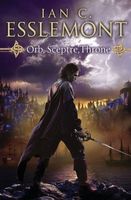 Tytuł: Orb Sceptre Throne
Tytuł: Orb Sceptre Throne